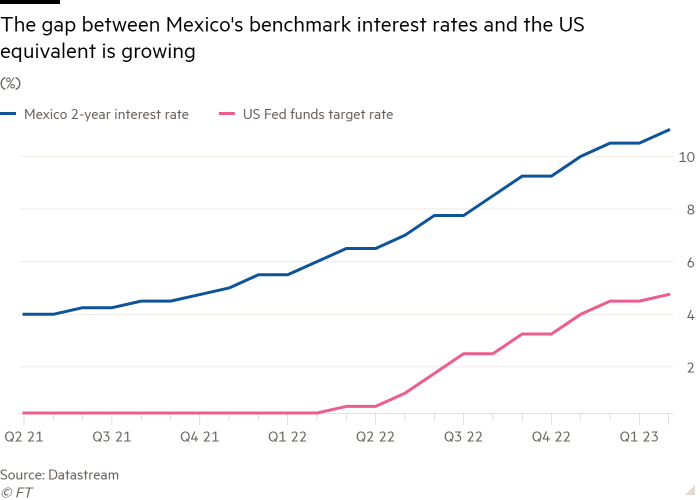Mexico’s peso has touched its strongest level in more than five years as the country’s relatively high interest rates, tight fiscal policy and investment opportunities accruing from its proximity to the US make it a favourite for currency investors.
The peso is the top performing major currency this year, according to Bloomberg, and has more than recovered from its pandemic weakness. It has risen 8.5 per cent this year to trade above 18 to the dollar.
That compares with the South African rand weakening 7.1 per cent and the Brazilian real gaining 2.4 per cent in the same period.
Moreover, the peso has increasingly become the vehicle for emerging market investors who want to borrow in a currency with a low interest rate, like the dollar, to buy assets offering higher rates of return, known as the carry trade.
The trends that have propelled Mexico’s currency are likely to have some staying power, analysts said.
“In the medium term we see a strong peso,” said Gabriel Casillas, head of Latin America Economics at Barclays. “Within Latin America, Mexico looks very good in almost every way.”
Mexico’s currency is benefiting from a confluence of domestic and international factors. The country, which shares a 2,000-mile border with the US, is set to be a prime beneficiary of companies focusing on their supply chains nearer key markets and away from China in a phenomenon known as “nearshoring”.
Mexico is part of the USMCA free trade agreement with the US and Canada and was included in recent green subsidies under Washington’s Inflation Reduction Act. These have helped it attract investment in its traditionally strong auto sector, which has lower wages than its northern neighbour.
BMW said last month it would spend €800mn to expand electric vehicle production in Mexico while Tesla announced last week it would build a new factory in northern Mexico that officials said would start off as a $5bn investment, one of the country’s largest in recent years. The news helped push up the peso even further against the dollar.

Foreign direct investment in Mexico hit $35.3bn last year, the highest level since 2015, according to economy ministry data. Transport manufacturing accounted for 12 per cent of that.
Another source of foreign income has been resilient remittances from Mexican migrants in the US.
The transfers from abroad now make up 4 per cent of the country’s gross domestic product. Even after growing to record levels last year, in January remittances were 12.5 per cent higher than the same month a year earlier, according to Bank of Mexico figures.
Mexico’s central bank, which has had a new governor Victoria Rodríguez Ceja since last year, has also proved to be more hawkish than many expected. The bank’s five-member board began raising interest rates in June 2021, nine months before the US Federal Reserve, and has increased its benchmark rate at 14 consecutive meetings from 4 per cent to 11 per cent.
The spread over the Fed’s fed funds target rate has grown from 3.75 per cent to 6.25 per cent, adding to the peso’s attractiveness.

The market is betting on further hikes since inflation started rising again in December after peaking in September and dropping in the following two months.
Mexican president Andrés Manuel López Obrador’s fiscal austerity has also helped prop up the peso. The populist leader, who flies commercial and prides himself on being a man of the people, has slashed government spending and run small deficits.
During the pandemic, he resisted intense pressure to implement large support packages for businesses and individuals.
His stance has won him favour with currency investors relative to other leaders in Latin America, like Gustavo Petro in Colombia and Brazil’s new president, Luiz Inácio Lula da Silva.
“We have a lot of new presidents . . . and it’s not clear whether they are going to be fiscally responsible,” Casillas said.
The news is not all positive. Despite investor confidence in the peso and healthy levels of foreign investment, Mexico’s economic growth has fallen short of potential for decades, economists said.
Since López Obrador took office in 2018 the economy has barely grown and lagged behind regional peers in recovering from the pandemic. This year analysts expect growth of just 1.2 per cent, according to a central bank poll.
Banco Base analyst Gabriela Siller said it was not a coincidence that the peso was now back close to levels seen in 2018, just before López Obrador won the presidency. Early fears that he would try to end the central bank’s autonomy or stay in power beyond the strict six-year term limit had dissipated, she said.
However, structural problems remain, such as the fragile rule of law, with little expectation of improvement in the medium term. Moves by López Obrador to weaken autonomous bodies and change the rules in the electricity market have also raised investor concerns.
Those long-term challenges will continue to hold back investment, JPMorgan economist Gabriel Lozano said in a recent note.
“Had a long-term strategy to boost investment been in place, we think Mexico could have been ready to boost nearshoring earlier,” he said.






